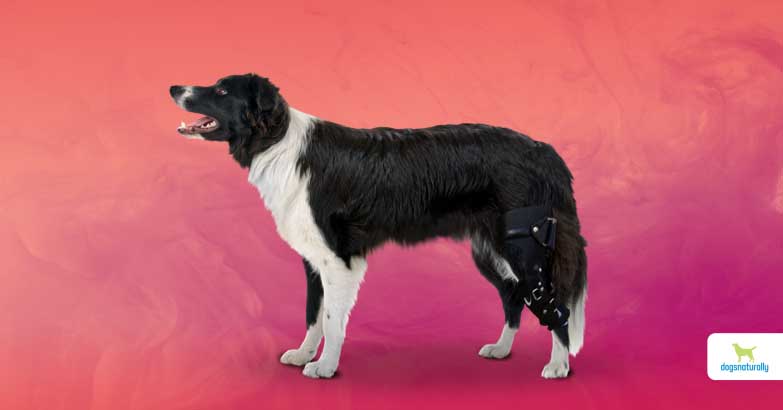Managing cruciate ligament damage in your dog is more complicated than the conventional choices of anti-inflammatories and surgery. Canine rehabilitation, sometimes using CCL braces for dogs, is a growing discipline that offers alternatives to surgery.
So we asked Dr Francisco Maia PT, DPT, CCRT about cruciate damage and whether CCL braces for dogs work. First, he provided some background on how cruciate damage happens.
What Is Cruciate Damage In Dogs?
The cranial cruciate ligament (CCL) is a primary stabilizer of your dog’s knee. The word cruciate is derived from the Latin crux meaning cross. Two ligaments cross to stabilize the knee and prevent osteoarthritis or arthritis. The CCL in dogs is equivalent to the anterior cruciate ligament (ACL) in humans. But CCL injuries in dogs are quite different from ACL tears in humans.
What Causes Cruciate Damage In Dogs?
CCL tears are the most common orthopedic issue in patients and that’s because it’s not an injury … it’s a degenerative condition.
In humans an ACL tear is usually a one-off acute injury that often happens during sports activity.
But that’s not how cruciate damage happens in dogs. When my clients bring in dogs with CCL tears, I have to explain that the injury probably didn’t happen at a recent visit to the park or from tripping on stairs … although those might worsen the problem or make the symptoms flare up.
In dog cruciate tears, they already have degenerative joint issues. Then little by little, there are micro-tears within the cruciate ligament. In time these tears get bigger and turn into a partial tear and even a full tear. It’s anyone’s guess as to which side will give out first.
So the injury probably began weeks or months before the owner noticed any pain or limping. With dogs there’s a higher incidence (60% or so depending on which research you read) of the same injury happening on the other knee. But it’s not because they twisted the other leg.
It’s because there’s the same degenerative component to it.
Can Dogs Heal From CCL Injury Without Surgery?
A lot of dogs can have a minor tear and their body adapts to it and they move on.
Sometimes I’ll find a medial buttress in patients that I’m treating for arthritis. It’s a bony callus on the medial side of the knee that usually occurs when a CCL tear has healed. When I ask if the dog has a history of a CCL tear … either he hasn’t, or the owner wasn’t aware of it.
Every case is different. But we’ve rehabbed plenty of patients who’ve resumed their active lifestyle without needing surgery or a brace.
RELATED: Learn more abput dog CCL recovery without surgery …
Can CCL Braces For Dogs Help?
Yes. A cruciate brace can definitely be part of the process, especially when the client is looking at conservative management. And I’ve seen good results. Cruciate braces for dogs create stability within the joint so the dog can gradually be functional and enjoy life as an active dog. When using a brace, over time the body adapts and creates scar tissue (the medial buttress I mentioned earlier).
So the goal of using the brace is to provide stability and create scar tissue. At first you’d use the brace frequently, then gradually less and less. Eventually you’d only use it to give extra support in more strenuous circumstances … like longer walks, playing off-leash, hiking.
And you always want to combine the brace or surgery with physical therapy and rehabilitation to help the body heal and adapt … and of course, get stronger. Strengthening those muscles is what’s going to help in the long run.
How Do You Choose Cruciate Braces For Dogs?
The brace itself is tricky with dogs. Most human knee joints are very similar, but with dogs there are many variables. There are huge differences in dog sizes, breeds and knee joint angles. So I really caution against using an off-the-shelf brace.
A cruciate brace for your dog must be customized to your dog’s circumstances and condition. You’ll need to use a company that can measure and fit a dog for a brace … ideally, a company familiar with animal rehabilitation.
What’s The Cost Of Cruciate Braces For Dogs?
A brace must be custom-made to your dog’s size, shape, joint and angle. You also have to factor in the consult and the time to measure and then get it cast and fitted. When you account for all that you’re looking at a cost between $800 and $1,500.
We can’t consider the brace a cheap alternative to surgery. Yes, it’s cheaper than surgery. But surgery does show better outcomes in the long run.
Do CCL Braces For Dogs Work?
I’ve seen good results with clients using cruciate braces. But we need more in-depth research to show the long-term benefits of using a brace.
Are There Problems With Cruciate Braces For Dogs?
The main thing is it needs to be a custom brace to give it a chance to work properly with the dog’s physical needs.
When deciding between conservative management or surgery, you need to keep all the variables in mind. And that’s why each case is different and nothing is a one-size-fits-all approach … even deciding whether a brace is an option or not.
Not every dog is going to adapt well to the brace. I tell clients to keep that in mind. You don’t want to spend all that money and find your dog just doesn’t like the brace and can’t wear it. So first, it’s a good idea to go to a clinic and try an off-the-shelf brace for a few minutes to see if your dog will wear it.
Do CCL Braces For Dogs Eliminate Surgery?
Braces can be an option with a conservative management approach. But I always caution there’s the chance of a setback.
This is especially true when the dog has improved and is getting better and is slowly being released to do some off-leash activities. That’s when they’re putting the most stress on their knee joint with the jumping, pivoting, changing directions…
When Is Surgery The Only Option For CCL Injuries?
It depends on whether it’s a partial or a full CCL tear. We only know 100% if it’s a full tear when the surgeon goes inside the joint. Beforehand we only have a general idea based on the hands-on assessment. But if we suspect a full tear, especially if there’s also a painful meniscus tear, then surgery can offer a better outcome. A partial tear can be managed conservatively with rehabilitation and perhaps a brace.
If there’s no meniscus tear, then the outcome for conservative management using a CCL brace is a little better.
How Long Should A Dog Wear A Cruciate Brace?
We take a very progressive and slow approach and ideally wait until the 6-month mark. Then your dog can start working on off-leash activity and build up to more strenuous outings. We know the body needs to heal first, decreasing inflammation and slowly building muscle. This lets the body adapt by building that scar tissue around the knee joint.
Should All Dogs With Joint Problems Wear Cruciate Braces?
There’s no need to wear a knee brace all the time. The only time to do so is if it’s part of a CCL rehabilitation program. If you’re managing a dog with arthritis or patella luxation (another fairly common knee condition), a brace won’t help with that.
Can A Dog Live Comfortably With A Torn Cruciate?
Yes, he can. But each case is so individual. Even when choosing surgery you need to keep a variety of factors in mind. If your dog is on the younger side with many years ahead of him, then surgery may be a better option than it is for an older dog.
You need to consider your dog’s energy level. You might have a 3 or 4-year-old couch potato. who isn’t running up the walls. In that case a conservative approach can be useful. Or you can have an active dog that hikes and plays off-leash a lot and then you may lean toward surgery.
References
- Aragon et al. Applications of Evidence-Based Medicine: Cranial Cruciate Ligament Injury Repair in the Dog. Veterinary Surgery, Vol 34, issue 2, March 2005.
- Jergler, D. Why You Should Consider Nonsurgical Care For CCL Disease. Veterinary Practice News. June 2015.
- Evelyn Orenbuch, DVM, DACVSMR, CAVCA. Nonsurgical treatment of CCL tears. Veterinary Practice News, August 2018.
- Andrea L Looney, DVM, DACVAA, DACVSMR. Nonsurgical perspectives on CCL disease. Veterinary Practice News, September 2018.
- Sherman O Canapp Jr., DVM, MS, CCRT, DACVS, DACVSMR. Conservative treatment options for partial and complete CCL tears in dogs. Veterinary Practice News, November 2018.
- Katja L. Wucherer, DVM et al. Short-term and long-term outcomes for overweight dogs with cranial cruciate ligament rupture treated surgically or nonsurgically JAVMA. May 15, 2013, Vol. 242, No. 10,













